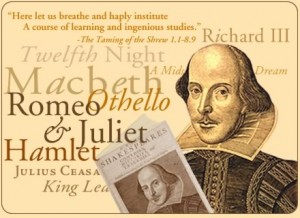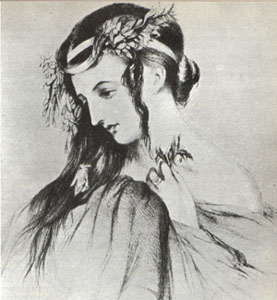The Food of Love
William Shakespeare added about 1,600 words to the English language, he wrote close to 40 plays and he left us with indelible characters that range from Hamlet to Shylock. And it’s not only in the world of letters that his influence is incalculable. The musical repertoire would be much poorer without his inspiration too. In addition to the myriad examples of incidental music written for his plays (Mendelssohn’s “A Midsummer Night’s Dream” and William Walton’s “Henry V” spring to mind) there are also operas, ballets and concert music.
“Romeo and Juliet” seems to have been the play that has captured composers’ imaginations to the greatest degree—even works that have been given a different title, like Bellini’s opera, “The Capulets and the Montagues” or Bernstein’s “West Side Story.” Peter Ilyich Tchaikovsky wrote his fantasy overture inspired by “Romeo and Juliet” when he was still finding his voice as a 28 year old composer teaching at the Moscow Conservatoire in 1869. The first version was not well received and he wrote a second version almost immediately. Then he let it rest for a decade before he composed the definitive version that is now one of the most beloved works in the repertoire, conjuring up beautifully the quiet religion of Friar Lawrence, the warring Montagues and Capulets, and the young “star-crossed lovers.”
The other great Russian musical interpretation of “Romeo and Juliet” is Sergei Prokofiev’s exquisite ballet from 1935, his first major work after returning to Russia from exile after the Revolution. It is wonderful to listen to the three suites he drew from the ballet, but there is nothing to beat the emotion of watching the clashing sword fights, the spectacular “Dance of the Knights” and the poignant lovers’ pas de deux playing out on the stage to Prokofiev’s music.
When Charles Gounod was 19 years old, he attended a rehearsal for Hector Berlioz’s dramatic symphony, “Roméo et Juliette”, and it made a vivid impression on him. By the time he wrote his own version of “Roméo et Juliette”, almost thirty years later in 1867, he had already composed eight operas, including “Faust”, his most famous. Despite the time lapse since he had first heard Berlioz’s work, you can still hear the older composer’s influence in Gounod’s opera—in the opening prologue, in Mercutio’s Queen Mab scene, and in Romeo’s death.
Berlioz was deeply enamored of Shakespeare. He had fallen in love with his work when he saw a production of “Romeo and Juliet” in Paris in 1827. He not only fell in love with Shakespeare’s work but also with the actress who played Juliet (and Ophelia), Harriet Smithson, and that resulted in a rather disastrous marriage. The love affair with Shakespeare continued throughout Berlioz’s life, though, and when he referred to “Romeo and Juliet” as “the supreme drama of my life” he meant it in more ways than one. He produced his dramatic symphony inspired by “Romeo and Juliet” in 1839 and other Shakespearean inspirations followed: overtures for “The Tempest” and “King Lear”, a funeral march for the final scene in “Hamlet”, and his opera, “Béatrice and Benedict”, based on Shakespeare’s sparring characters in “Much Ado About Nothing.”
Tchaikovsky didn’t limit himself to one idea inspired by Shakespeare either. Between the first and final versions of “Romeo and Juliet” he turned to two other Shakespeare plays. In 1873 he wrote a symphonic fantasia based on “The Tempest”, which is not to be confused with his earlier overture, “The Storm”, although it does have some very effective storm music as well. Then in the late 1880s, Tchaikovsky was commissioned to write the incidental music for a production of “Hamlet” in St. Petersburg, but he didn’t meet the deadline, so he turned the music into a fantasy overture inspired by the character of Hamlet. Three years later, he was again approached to write incidental music for the play, and he incorporated a shortened version of the fantasy overture for that.
Playing the role of Hamlet is the benchmark for most classical actors and, not surprisingly, many composers have tried to capture the complexities of the play in music. Around the same time that Tchaikovsky was beginning to write his music inspired by “Hamlet”, the American composer, Edward MacDowell, was inspired by a production of the play that he saw in London as a young newlywed. His first foray into writing symphonic poems took the form of two character studies of Hamlet and Ophelia. In Russia, the same stage director who had worked with Prokofiev to bring his ballet, “Romeo and Juliet”, to the stage also asked him to write incidental music to “Hamlet” for a Leningrad production in 1938. Even though this music didn’t catch on in the way that “Romeo and Juliet” had, and the score wasn’t published during his life time, it has some exceptional music, especially Fortinbras’s Final March. Shakespeare’s tragic hero also inspired a concert overture from the great Romantic violinist, Joseph Joachim, who was such a fan of Shakespeare (he wrote an overture on “Henry IV” as well) that he had a portrait of the playwright in study, alongside one of Beethoven.
In 1918, Richard Strauss published three Ophelia Songs (an eerie depiction of a deranged mind) but his better known Shakespeare-inspired work is his earlier tone poem, “Macbeth”. He struggled with it (which seems fitting for such a troublesome play) and, even though he kept revising it extensively, it never quite reached the same stature as some of his other great tone poems.
“Macbeth” presented problems for Guiseppe Verdi too. The original 1847 version of his opera was very well received in Italy, but when he revised it for the Paris audience in 1865 it fell out of popularity—rather to his surprise because he thought he had “done quite well with it.” In any event, “Macbeth” had given him a taste for setting Shakespeare to music and his final two operas, “Otello”, which could almost have been called “Iago” on the strength of the Act II “Credo” aria, and “Falstaff”, based on the comic character from Shakespeare’s “The Merry Wives of Windsor”, are crowning glories at the end of his career.
Edward Elgar wrote his own vivid portrait of Shakespeare’s “fat knight” in his symphonic study “Falstaff” in 1913. Truly, the list of compositions inspired by Shakespeare is endless, but some other honorable mentions must include Antonin Dvorak’s powerful concert overture “Othello” from his trilogy, “Nature, Life and Love”; Benjamin Britten’s 1960 opera, “A Midsummer Night’s Dream”; the incidental music that Jean Sibelius and Arthur Sullivan each wrote for “The Tempest”; Joseph Suk’s touching overture inspired by “A Winter’s Tale”; the heart melting setting that Engelbert Humperdinck made for Act V of “The Merchant of Venice” when Lorenzo and his beloved Jessica muse, “On such a night…”; and Ralph Vaughan Williams‘ “Serenade to Music” from 1938, inspired by that same scene.
When Duke Orsino says at the beginning of “Twelfth Night”, “If music be the food of love, play on” he is pining away for love of Olivia; he wants a surfeit to cure him of his love. But we know, as Shakespeare knew, that this would never work. The more one hears beautiful music, whether it is inspired by Shakespeare or not, the hungrier one is for more.
Here at WBJC, we are only too happy to cater to that.









